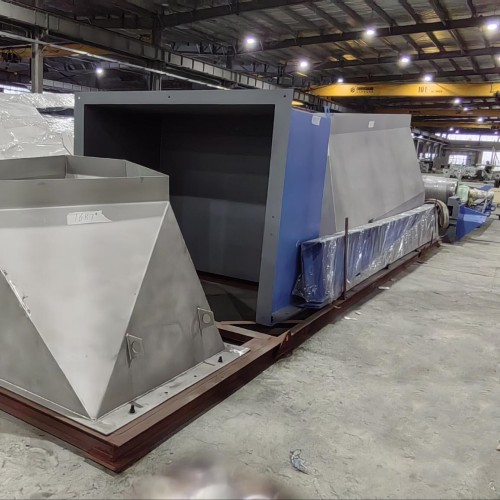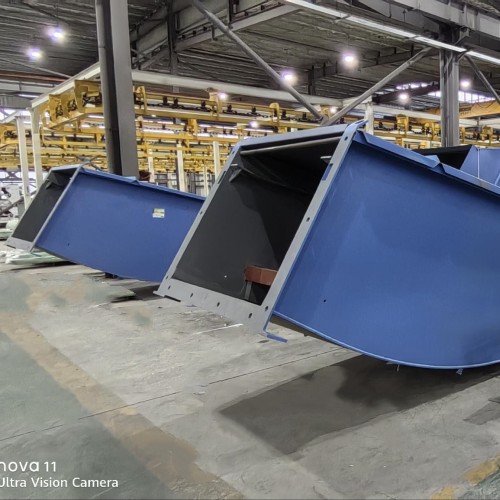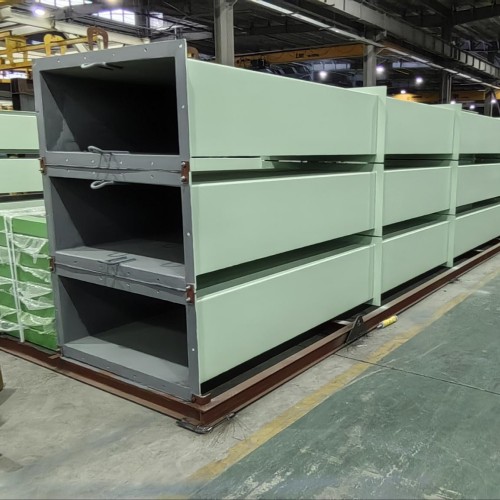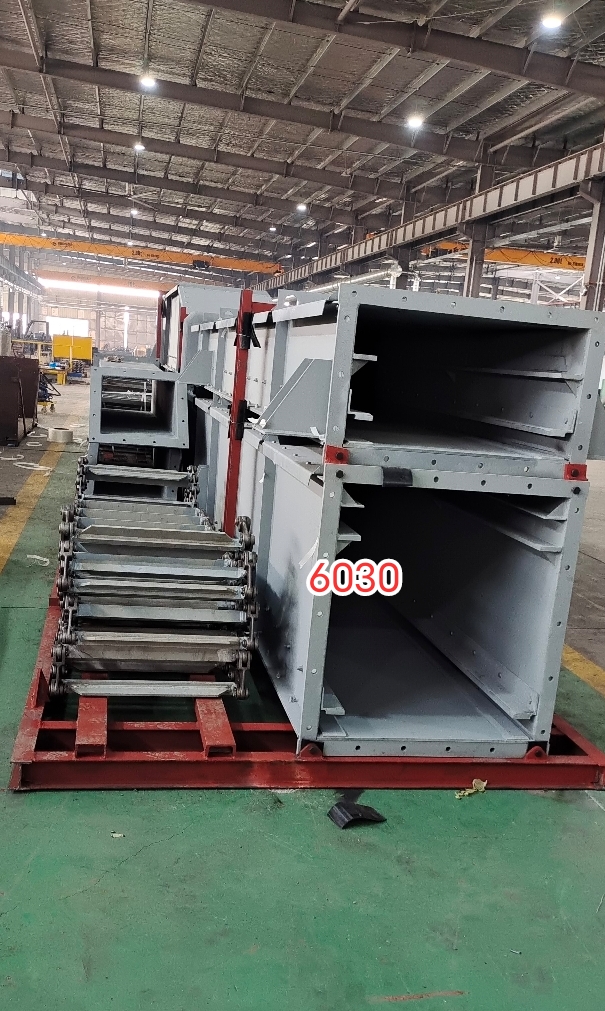
Grate slag conveyor
Grate Slag Conveyor
A Grate Slag Conveyor is a specialized type of conveyor used primarily in waste-to-energy plants, steel mills, and other industrial processes to transport slag generated from combustion or metal smelting. It is designed to handle hot, abrasive, and dense slag while ensuring safe, efficient, and continuous material flow. This system is often used to move slag from the incinerator or furnace grate to storage or disposal areas.
Key Features of Grate Slag Conveyors
- High Temperature Resistance:
- Grate slag conveyors are built to withstand extremely high temperatures, often in excess of 1,000°C, ensuring they can safely handle hot slag without damage to components.
- Durable Construction:
- Constructed from heat-resistant and wear-resistant materials such as stainless steel or hardened steel to resist corrosion, abrasion, and extreme heat.
- Enclosed System:
- The conveyor system is often enclosed to prevent slag dust from escaping and to ensure that any hot, molten slag is safely transported without the risk of spillage or contamination.
- Efficient Slag Cooling:
- In some designs, the grate conveyor features water or air cooling mechanisms that help cool the slag during transport, reducing the risk of fire hazards and improving safety.
- Continuous Operation:
- Designed for continuous operation in harsh industrial environments, reducing downtime and enhancing overall plant efficiency.
- Large Load Capacity:
- Grate slag conveyors are capable of handling large volumes of dense and heavy slag, making them suitable for industries that generate substantial amounts of slag daily.
Working Principle of Grate Slag Conveyors
- Slag Collection:
- The slag is collected from the furnace, combustion chamber, or grate area and fed onto the conveyor.
- Transport:
- The slag moves along the conveyor, which consists of a series of interlocking, heat-resistant grates. These grates allow the slag to pass through while also enabling airflow or cooling mechanisms if needed.
- Cooling (if applicable):
- In some systems, the slag may be cooled either by water quenching or air cooling systems as it moves along the conveyor to reduce the temperature before reaching the discharge point.
- Discharge:
- The cooled or hot slag is discharged at the end of the conveyor into a collection area, storage, or disposal site, where it can be further processed or disposed of safely.
Types of Grate Slag Conveyors
- Water-Cooled Grate Slag Conveyors:
- Ideal for: Handling extremely hot slag and preventing temperature build-up that could damage the conveyor system.
- Features:
- Grates are cooled by circulating water beneath or through them, preventing excessive heat accumulation.
- Suitable for high-temperature environments where rapid cooling is necessary.
- Air-Cooled Grate Slag Conveyors:
- Ideal for: Slag that is moderately hot and does not require immediate cooling.
- Features:
- Uses air to cool the slag as it passes along the conveyor.
- Air-cooled systems are less complex but are limited by the temperature of the slag they can handle.
- Heavy-Duty Grate Slag Conveyors:
- Ideal for: Large-scale operations in steel mills, waste-to-energy plants, and power plants where large volumes of dense slag need to be handled.
- Features:
- Heavy-duty construction with robust grates capable of withstanding high loads and continuous operation.
- These conveyors are often designed for heavy-duty applications with high abrasion resistance.
- Inclined Grate Slag Conveyors:
- Ideal for: Transporting slag from lower to higher elevations within a plant or facility.
- Features:
- Slag is moved at an incline to reduce the need for multiple conveyors.
- Efficient in space-constrained environments where vertical movement is needed.
Applications of Grate Slag Conveyors
- Power Plants:
- Bottom Ash and Fly Ash: Grate slag conveyors are used to transport bottom ash from coal-fired or waste-to-energy power plants. They handle the byproduct produced by combustion processes.
- Steel Mills:
- Metal Slag: Steel mills generate slag during metal smelting. Grate slag conveyors transport hot metal slag to cooling areas, preventing potential hazards and facilitating further processing.
- Waste-to-Energy Plants:
- Incineration Slag: Waste-to-energy plants produce slag as a byproduct of burning municipal solid waste. Grate conveyors move this slag to storage or disposal areas.
- Cement Plants:
- Clinker Slag: In cement production, slag can be produced as a byproduct. Grate conveyors are used to handle and transport this material.
- Foundries:
- Casting Slag: Foundries produce slag during the metal casting process. Grate slag conveyors help manage the byproduct and keep operations running smoothly.
Advantages of Grate Slag Conveyors
- Temperature Control:
- By utilizing water or air-cooling features, these conveyors prevent overheating and ensure that the slag is safely cooled before further handling.
- Durability:
- Built to withstand high temperatures and abrasive materials, ensuring long service life even in the harshest industrial environments.
- Reduced Downtime:
- Continuous, efficient operation minimizes downtime and reduces maintenance needs.
- Safe Handling:
- The enclosed design helps mitigate safety risks associated with hot or hazardous slag by containing dust and preventing the material from spilling.
- Space Efficiency:
- Grate slag conveyors can be designed for various configurations (horizontal, inclined, vertical), making them flexible in terms of space constraints.
Maintenance and Operational Considerations
- Wear and Tear:
- Due to the abrasive nature of slag, regular inspections and maintenance are needed to replace worn components such as the grates, chains, or cooling system parts.
- Cooling Systems:
- Maintenance of water or air-cooling systems is crucial to ensure effective cooling and prevent overheating, which could damage the conveyor system.
- Temperature Monitoring:
- Regular monitoring of slag temperature is important to ensure the system operates safely and efficiently, preventing overheating and fire hazards.
- Inspection Ports:
- Inspection and access ports should be integrated for ease of maintenance and cleaning, ensuring that potential issues are addressed quickly.
Comparison with Other Slag Conveyor Systems
| Feature | Grate Slag Conveyor | En-Masse Chain Conveyor | Belt Conveyor |
|---|---|---|---|
| Temperature Resistance | Very high (water-cooled) | Moderate to high | Moderate |
| Durability | Very high (abrasion-resistant) | High | Moderate |
| Cooling System | Yes (water or air-cooled options) | No | No |
| Energy Efficiency | Moderate | High | High |
| Maintenance Needs | Low to Moderate | Low | Moderate to High |
Why Choose a Grate Slag Conveyor?
- Efficient Handling of Hot Slag:
- Grate slag conveyors are specifically designed to handle high-temperature slag, providing a safe and efficient way to transport material.
- Customizable Cooling Options:
- The ability to incorporate water or air cooling systems ensures that slag can be safely cooled while it is being transported.
- High Durability:
- The heavy-duty construction of grate slag conveyors guarantees long service life and reduces downtime.
- Safety Features:
- The enclosed system prevents slag from spilling, minimizing risks associated with handling hot or abrasive materials.
- Space Flexibility:
- Available in horizontal, inclined, and vertical configurations, making it adaptable to various plant layouts.
If you need more detailed specifications or help designing a Grate Slag Conveyor for your specific plant or facility, feel free to share more details, and I’ll be happy to assist further!
Process
The high-temperature ash discharged from the furnace is firstly broken into small pieces by the roller-type slag breaker to facilitate cooling and transportation.
After the crushing of the ash and slag into the water-cooled screw slag extractor and between the screw blade and the outer cylinder cooling heat transfer back out.
If necessary, air lock (star ash discharge valve) can be provided at the outlet of the slag cooler.
Ash inlet temperature is less than 900 ℃, clinker size less than 100 mm, the transmission distance is 4 to 7 m, the level of the installation
Advantages
1. Facilitate the comprehensive utilization of slag.
2. Reasonable structure design, reliable operation, safe operation and good sealing performance.
3. Good load adaptability and remote control
Scraper slag remover
1. The cast stone slab is placed at the bottom of the base groove, which can effectively improve the wear resistance of the material and prolong the service life of the base groove.
2. The scraper material of the double-chain scraper is cast steel, the transmission chain is 25MNV high-strength material for mining, and the structure is double-row ring welding. In the process of transporting ash, the tightness of the chain can be automatically adjusted by the device at the front of the device.
3. The double-chain slag removing machine can reduce the labor intensity of the furnace workers, improve the working conditions of the boiler room, and ensure the boiler production efficiency to the greatest extent.
4. Compared with other closed type slag removing machines, the double-chain type is an open design, which can ensure that all ash can be discharged to the outside of the boiler.
5. The scraper support is a cast stone rail support method, which avoids various problems of supporting by the rollers, and can effectively reduce the maintenance cost of the equipment.
6. It is suitable for the slag removal of single-drum boilers with all slag outlets arranged at the rear and lower parts of the boiler.
7. The chain is automatically tensioned by manual or machine. The double overload protection system of the motor can ensure that the chain is not dragged, not stacked, and the ash is transported smoothly, meeting the requirements of industrial boilers and heating boilers.
Boiler removal scraper type
TYPE (Length <8M Slag 0.6-2.3T/H)
For boiler 2ton/h~25ton/h





